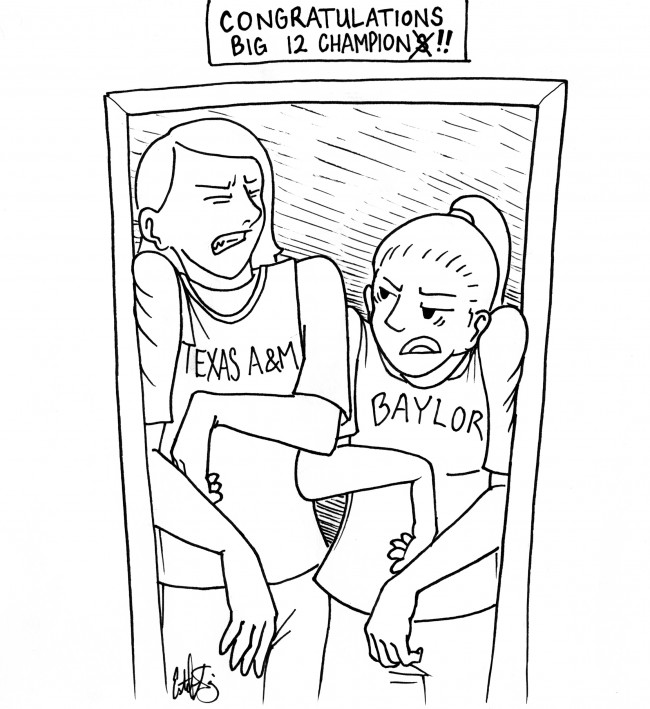
This weekend, the Baylor Lady Bears head to the Dallas Regional for the Sweet 16 and possibly the Elite Eight round of the NCAA tournament. The Big 12 is undoubtedly pleased to see one of its teams enjoy so much success and possibly earn a Final Four berth.
Unfortunately, the conference has to be angry about the combination of teams at the Dallas Regional, because if the No. 1 and No. 2 seeds reach the Elite Eight round, two very strong Big 12 teams will have to compete for one spot in the Final Four.
Shock and surprise described the scene last Monday, when the NCAA women’s basketball tournament bracket was revealed and slotted No. 1 seeded Baylor and No. 2 seeded Texas A&M in the same regional.
Each of four regionals begins with 16 teams and is narrowed down to one in single elimination format, with the four regional winners advancing to Indianapolis for the Final Four. In this year’s tournament, Baylor and Texas A&M were by far the strongest seeded teams; the next highest seed was a No. 6 seed earned by Oklahoma in the Dayton Regional.
But, to both Baylor and Texas A&M coaches’ astonishment, the NCAA chose to place the Big 12’s two theoretically best chances at a Final Four appearance in the same regional.
Baylor’s Kim Mulkey said she would have liked to see new teams throughout the tournament, and Texas A&M’s Gary Blair admitted the placement of the two teams was not good for the conference. One Texas A&M guard used the word “shocked” to describe her reaction but refused to complain about the situation.
Despite the explanation given by basketball analysts, the NCAA’s decision to place Baylor and Texas A&M in the Dallas Regional is unfair to the entire Big 12 conference.
The NCAA’s main reason for placing the Lady Bears and Aggies together is the geographical proximity that both teams have to Dallas.
If both teams advance to the Elite Eight, there should be a large crowd as many Baylor and Texas A&M supporters are either in or close to Dallas.
It is not the first time the NCAA placed two same-conference No. 1 and No. 2 seeds in the same regional. In 2008, No. 1 Connecticut and No. 2 Rutgers, both Big East members, met in the Elite Eight, with Connecticut winning.
In this year’s tournament, the Pac-10 also had No. 1 seed Stanford and No. 3 seed UCLA in the Spokane Regional. Those two teams were the Pac-10’s two highest seeded teams, and the only other Pac-10 team in the tournament is No. 7 seeded Arizona State.
With both the Big 12 and Pac-10, the NCAA blatantly disregarded competition for the sake of geographical principles. This should not have take priority over equal opportunity for each conference.
It would not have been difficult to place Texas A&M in the Spokane Regional, where Blair thought his team would be. The NCAA would have lost money on travel expenses and sold fewer Elite Eight tickets in Spokane if the Aggies advanced that far, but the Big 12 would still have had a legitimate chance at having two Final Four teams.
That is not to say that No. 6 seeded Oklahoma did not have a chance at making this year’s Final Four, but only twice in the last 10 women’s tournaments has a team seeded lower than No. 4 reached the Final Four.
Nothing is taken for granted, either. Tuesday’s Elite Eight game could feature the No. 5 seed University of Wisconsin-Green Bay and No. 6 seed Georgia, rendering this controversial bracket placement irrelevant.
But if Baylor and Texas A&M play to their capabilities in Sunday’s Sweet 16, fans will watch two Final Four-caliber teams face off in the Elite Eight. Unfortunately for the Big 12, one of those squad’s tournament run will then end.







